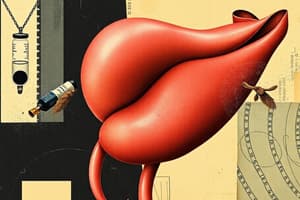Podcast
Questions and Answers
What is the primary characteristic of Type 1 Diabetes Mellitus?
What is the primary characteristic of Type 1 Diabetes Mellitus?
- Hyperinsulinemia and polyphagia
- Hypoglycemia and polydipsia
- Autoimmune destruction of pancreatic beta cells (correct)
- Insulin resistance and obesity
What is the most common age of onset for Type 1 Diabetes?
What is the most common age of onset for Type 1 Diabetes?
- 4-6 years and 11-13 years (correct)
- 1-3 years and 17-19 years
- 7-10 years and 14-16 years
- 20-25 years and 30-35 years
What is the risk of developing Type 1 Diabetes in the general population?
What is the risk of developing Type 1 Diabetes in the general population?
- 1 in 500
- 1 in 1000
- 1 in 100
- 1 in 300 (correct)
What is the most common complication of Type 1 Diabetes?
What is the most common complication of Type 1 Diabetes?
Which of the following racial groups has the highest reported incidence of Type 1 Diabetes?
Which of the following racial groups has the highest reported incidence of Type 1 Diabetes?
What is the term for the symptom of burning or tingling sensations in the extremities in diabetes?
What is the term for the symptom of burning or tingling sensations in the extremities in diabetes?
Approximately how many new cases of Type 1 Diabetes are diagnosed annually in the US?
Approximately how many new cases of Type 1 Diabetes are diagnosed annually in the US?
What is the name of the condition resulting from the increase in plasma keto acids that lowers blood pH?
What is the name of the condition resulting from the increase in plasma keto acids that lowers blood pH?
What is a common characteristic of patients with type 1 diabetes?
What is a common characteristic of patients with type 1 diabetes?
What is a distinguishing feature of diabetes type 1 from diabetes type 2?
What is a distinguishing feature of diabetes type 1 from diabetes type 2?
What is a serious acute complication of type 1 diabetes?
What is a serious acute complication of type 1 diabetes?
What is a common chronic complication of type 1 diabetes?
What is a common chronic complication of type 1 diabetes?
What is a major cause of death in patients with type 1 diabetes?
What is a major cause of death in patients with type 1 diabetes?
What is a factor that can affect pancreatic B-cell function?
What is a factor that can affect pancreatic B-cell function?
What is the name of the genes that are thought to predispose individuals to a destructive autoimmune process?
What is the name of the genes that are thought to predispose individuals to a destructive autoimmune process?
What is a possible outcome of poor glycemic control during pregnancy in women with type 1 diabetes?
What is a possible outcome of poor glycemic control during pregnancy in women with type 1 diabetes?
Which of the following is a characteristic of type 1 DM?
Which of the following is a characteristic of type 1 DM?
What is the primary cause of hyperglycemia in type 1 DM?
What is the primary cause of hyperglycemia in type 1 DM?
What is the underlying mechanism of ketoacidosis in type 1 DM?
What is the underlying mechanism of ketoacidosis in type 1 DM?
What is the primary cause of peripheral vascular disease in diabetes?
What is the primary cause of peripheral vascular disease in diabetes?
What is the underlying mechanism of neuropathy in diabetes?
What is the underlying mechanism of neuropathy in diabetes?
What is the critical blood glucose level above which leukocyte function is impaired?
What is the critical blood glucose level above which leukocyte function is impaired?
What is the primary cause of microalbuminuria in diabetes?
What is the primary cause of microalbuminuria in diabetes?
What is the definition of microalbuminuria?
What is the definition of microalbuminuria?
What is the primary characteristic of a patient with type 1 diabetes?
What is the primary characteristic of a patient with type 1 diabetes?
What is the term for a relatively mild and slowly progressive form of immune-mediated type 1A diabetes?
What is the term for a relatively mild and slowly progressive form of immune-mediated type 1A diabetes?
What is the primary cause of early symptoms of type 1 diabetes?
What is the primary cause of early symptoms of type 1 diabetes?
What is the primary purpose of periodically testing for HbA1C?
What is the primary purpose of periodically testing for HbA1C?
What is the recommended HbA1C level according to the American Diabetes Association?
What is the recommended HbA1C level according to the American Diabetes Association?
What is the significance of an elevated HbA1C?
What is the significance of an elevated HbA1C?
What is the similarity between HbA1C and fructosamine?
What is the similarity between HbA1C and fructosamine?
What is the predictive value of an elevated HbA1C?
What is the predictive value of an elevated HbA1C?
What is the significance of subnormal plasma insulin and/or C-peptide concentrations in diabetes?
What is the significance of subnormal plasma insulin and/or C-peptide concentrations in diabetes?
What is the purpose of measuring glutamic acid decarboxylase antibodies in diabetes?
What is the purpose of measuring glutamic acid decarboxylase antibodies in diabetes?
What is the significance of islet cell and anti-insulin antibodies in type 1 diabetes?
What is the significance of islet cell and anti-insulin antibodies in type 1 diabetes?
What is the most common complication of type 1 diabetes that can result in amputation of the lower extremity?
What is the most common complication of type 1 diabetes that can result in amputation of the lower extremity?
What is the most common procedure performed in conjunction with pancreatic transplantation in individuals with type 1 diabetes?
What is the most common procedure performed in conjunction with pancreatic transplantation in individuals with type 1 diabetes?
What is the probability of pancreatic graft survival after 1 year in patients undergoing simultaneous pancreas and kidney transplantation?
What is the probability of pancreatic graft survival after 1 year in patients undergoing simultaneous pancreas and kidney transplantation?
What is the potential hazard of using potent immunosuppressive drugs in patients undergoing pancreatic transplantation?
What is the potential hazard of using potent immunosuppressive drugs in patients undergoing pancreatic transplantation?
What is the potential benefit of using stem cells from the patient's own blood in the treatment of type 1 diabetes?
What is the potential benefit of using stem cells from the patient's own blood in the treatment of type 1 diabetes?
Flashcards are hidden until you start studying
Study Notes
Diabetes Type 1
- Diabetes mellitus is a catabolic endocrine disease characterized by hyperglycemia (elevated plasma glucose concentrations) and polyuria (frequent urination).
- Type 1 DM is an autoimmune process in which pancreatic islet beta cells are targeted and destroyed by cells of the immune system.
- Circulating insulin is virtually absent, and carbohydrate, lipid, and protein metabolism is abnormal.
- Patients are susceptible to weight loss and life-threatening ketoacidosis (increase in plasma keto acids that lowers blood pH).
Prevalence
- Type 1 DM is the most common metabolic disease of childhood.
- The overall incidence of type 1 diabetes in the US is 15 new cases per 100,000 people younger than age 18 per year.
- The risk in the general population for developing type 1 diabetes is 1 in 300, but increases 15-20 times among people with first-degree relatives with the condition.
- Caucasians have the highest reported incidence of type 1 DM.
Significance
- The significance of Type 1 DM lies in its chronic and progressive course, multiple clinical manifestations, and many potential life-threatening acute and chronic complications.
- Symptoms include frequent urination and nocturnal enuresis, constant thirst and hunger, blurred vision, weight loss, pruritus, weakness, fatigue, and paresthesias.
- Patients are prone to multiple infections, especially foot infections that may progress to gangrene and require limb amputation.
Causes and Risk Factors
- Type 1 DM is considered a multifactorial disorder in which both environmental factors and heredity play critical roles.
- Environmental factors that may affect pancreatic B function include mumps, rubella, coxsackie B4 viruses, and toxic chemical agents.
- Specific human leukocyte antigen (HLA) immune response genes on chromosome 6 are thought to predispose individuals to a destructive autoimmune process.
Pathophysiology
- Type 1 DM is characterized by an absolute insulin deficiency.
- Tissues dependent on insulin for glucose transport do not have glucose available as a substrate for the generation of energy.
- Production of glucose by the liver is not opposed by insulin and overproduction of glucagon by pancreatic a cells stimulates glycogenolysis and gluconeogenesis.
- Plasma glucose levels rise and hyperglycemia results.
Clinical Manifestations and Lab Tests
- The patient with type 1 diabetes is typically young, lean, and has a parent or sibling with DM.
- Early symptoms of type 1 DM are related to elevated blood glucose levels and a significant loss of water through the urinary tract.
- Major symptoms include increased thirst, increased urination, weight loss despite an increased appetite, fatigue, nausea, and vomiting.
- HbA1c is used to monitor glycemic control over the preceding 3 months.
- An elevated HbA1c is highly predictive of DM-induced microvascular complications.
Serious Complications and Prognosis
- The most serious acute complications of type 1 DM include ketoacidosis, hypoglycemic coma, dehydration, infections, and amputation of the lower extremity.
- Pancreatic transplantation has been performed in individuals with diabetes since 1966 and has resulted in consistent improvement in patient outcomes.
Studying That Suits You
Use AI to generate personalized quizzes and flashcards to suit your learning preferences.



